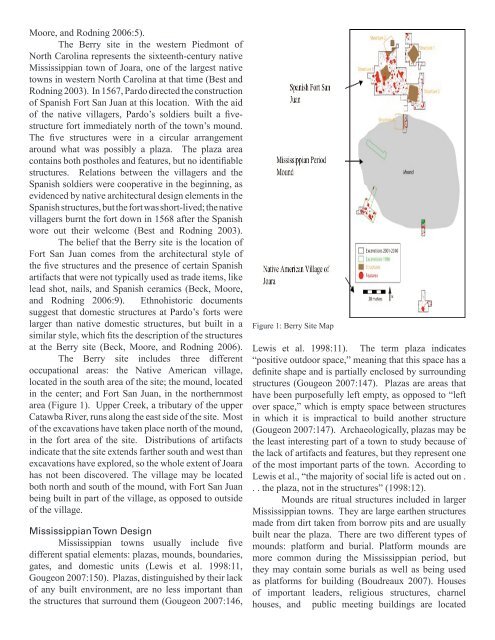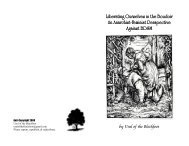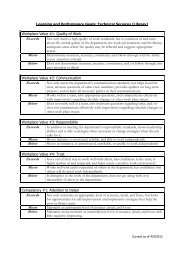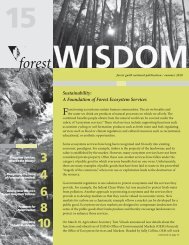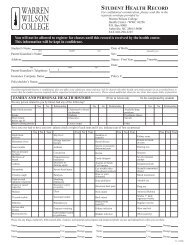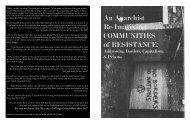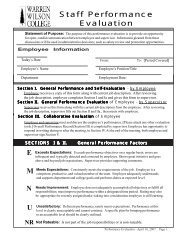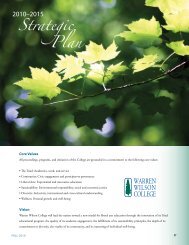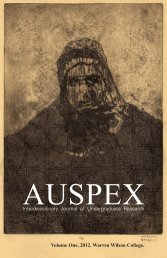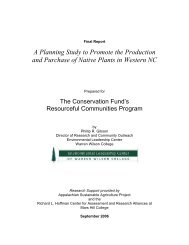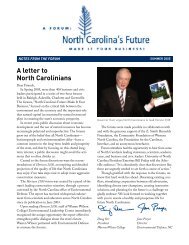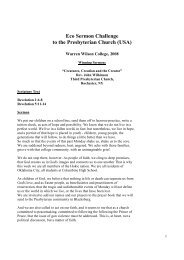Native American and Spanish Ancillary Structures - Warren Wilson ...
Native American and Spanish Ancillary Structures - Warren Wilson ...
Native American and Spanish Ancillary Structures - Warren Wilson ...
You also want an ePaper? Increase the reach of your titles
YUMPU automatically turns print PDFs into web optimized ePapers that Google loves.
Moore, <strong>and</strong> Rodning 2006:5).<br />
The Berry site in the western Piedmont of<br />
North Carolina represents the sixteenth-century native<br />
Mississippian town of Joara, one of the largest native<br />
towns in western North Carolina at that time (Best <strong>and</strong><br />
Rodning 2003). In 1567, Pardo directed the construction<br />
of <strong>Spanish</strong> Fort San Juan at this location. With the aid<br />
of the native villagers, Pardo’s soldiers built a fivestructure<br />
fort immediately north of the town’s mound.<br />
The five structures were in a circular arrangement<br />
around what was possibly a plaza. The plaza area<br />
contains both postholes <strong>and</strong> features, but no identifiable<br />
structures. Relations between the villagers <strong>and</strong> the<br />
<strong>Spanish</strong> soldiers were cooperative in the beginning, as<br />
evidenced by native architectural design elements in the<br />
<strong>Spanish</strong> structures, but the fort was short-lived; the native<br />
villagers burnt the fort down in 1568 after the <strong>Spanish</strong><br />
wore out their welcome (Best <strong>and</strong> Rodning 2003).<br />
The belief that the Berry site is the location of<br />
Fort San Juan comes from the architectural style of<br />
the five structures <strong>and</strong> the presence of certain <strong>Spanish</strong><br />
artifacts that were not typically used as trade items, like<br />
lead shot, nails, <strong>and</strong> <strong>Spanish</strong> ceramics (Beck, Moore,<br />
<strong>and</strong> Rodning 2006:9). Ethnohistoric documents<br />
suggest that domestic structures at Pardo’s forts were<br />
larger than native domestic structures, but built in a<br />
similar style, which fits the description of the structures<br />
at the Berry site (Beck, Moore, <strong>and</strong> Rodning 2006).<br />
The Berry site includes three different<br />
occupational areas: the <strong>Native</strong> <strong>American</strong> village,<br />
located in the south area of the site; the mound, located<br />
in the center; <strong>and</strong> Fort San Juan, in the northernmost<br />
area (Figure 1). Upper Creek, a tributary of the upper<br />
Catawba River, runs along the east side of the site. Most<br />
of the excavations have taken place north of the mound,<br />
in the fort area of the site. Distributions of artifacts<br />
indicate that the site extends farther south <strong>and</strong> west than<br />
excavations have explored, so the whole extent of Joara<br />
has not been discovered. The village may be located<br />
both north <strong>and</strong> south of the mound, with Fort San Juan<br />
being built in part of the village, as opposed to outside<br />
of the village.<br />
Mississippian Town Design<br />
Mississippian towns usually include five<br />
different spatial elements: plazas, mounds, boundaries,<br />
gates, <strong>and</strong> domestic units (Lewis et al. 1998:11,<br />
Gougeon 2007:150). Plazas, distinguished by their lack<br />
of any built environment, are no less important than<br />
the structures that surround them (Gougeon 2007:146,<br />
Figure 1: Berry Site Map<br />
Lewis et al. 1998:11). The term plaza indicates<br />
“positive outdoor space,” meaning that this space has a<br />
definite shape <strong>and</strong> is partially enclosed by surrounding<br />
structures (Gougeon 2007:147). Plazas are areas that<br />
have been purposefully left empty, as opposed to “left<br />
over space,” which is empty space between structures<br />
in which it is impractical to build another structure<br />
(Gougeon 2007:147). Archaeologically, plazas may be<br />
the least interesting part of a town to study because of<br />
the lack of artifacts <strong>and</strong> features, but they represent one<br />
of the most important parts of the town. According to<br />
Lewis et al., “the majority of social life is acted out on .<br />
. . the plaza, not in the structures” (1998:12).<br />
Mounds are ritual structures included in larger<br />
Mississippian towns. They are large earthen structures<br />
made from dirt taken from borrow pits <strong>and</strong> are usually<br />
built near the plaza. There are two different types of<br />
mounds: platform <strong>and</strong> burial. Platform mounds are<br />
more common during the Mississippian period, but<br />
they may contain some burials as well as being used<br />
as platforms for building (Boudreaux 2007). Houses<br />
of important leaders, religious structures, charnel<br />
houses, <strong>and</strong> public meeting buildings are located


